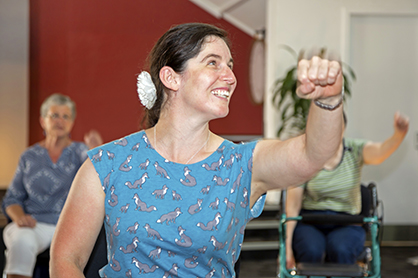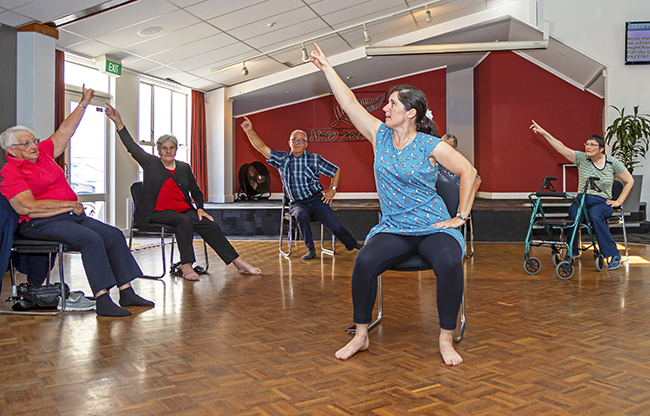Many of our baby boomers are living longer and more active lives than their parents.
Yet older New Zealanders who live with 'visible' neurological disorders can find it hard to remain socially connected and have limited options for physical activity.
Otago educated physiotherapist and dancer Rachel Horwell knows that dance can help many older Kiwis now living with dementia, Parkinson's, stroke, and chronic regional pain.
Inspired to move
Rachel is from Inglewood in the Taranaki but has strong family connections to Tapanui in West Otago.
She had always wanted to be part of a caring profession with a focus on human physiology - a career that helped people to help themselves - and physiotherapy appealed because it combines practical problem-solving and direct interaction with patients in ways that seemed real for a young woman born and raised in rural New Zealand.

Staff at the School encouraged Rachel to draw upon her deep knowledge of dance as a source of inspiration in movement for exercise. Here she leads dancers for warmup exercises which explore movements in space.
For similar reasons, Otago was always the first choice over the atmosphere and demands of a bigger city.
She recalls the encouragement of staff at the School, in particular, Andrea Mosley who acknowledged Rachel's love of dance and encouraged her to draw upon it as a source of inspiration in movement for exercise.
After graduation Rachel worked in the field of public health. She noticed that there were few engaging and enjoyable activities on offer for her patients in the medium term and grew concerned about the levels of social isolation and post-rehabilitation decline patients may experience after they left supportive hospital and community rehabilitation programmes.
Because dance is about being together, and the transcendent joy of movement, the universal language of dance can help to smooth the transitions from care to community.
Much stronger together
In some cases, drug therapy has shaped the lives of those with conditions such as dementia, Parkinson's, stroke, and chronic regional pain.
The startling effects of some medications on balance and stability may have led to patients showing higher levels of anxiety. Recent research indicates that environmental and socioeconomic factors also play a part in fall rates.
In the 1980's, researchers at the School of Physiotherapy formulated a range of strategies that later became known as 'the Otago Exercise Programme'. In time, such practical initiatives helped lower the incidence of damaging falls in scores of older New Zealanders. Insights gained from these ground-breaking studies now underpin many community exercise initiatives worldwide.
A tentative approach to physical activity leaves some more prone to falls and similar mishaps.
Stronger and more mobile patients live safer lives and make better connections.
A growing movement
The international movement Dance for PD® began in New York City in 2001.
Rachel travelled there in 2014 to attend a Dance for PD® Introductory Workshop with the Mark Morris Dance Group. Members of that Group had helped with the genesis and refinement of the original ideas about dance as therapy, and Rachel returned home inspired to help people here experience the joys and rewards of adapted, inclusive dance classes.
After some years working with DaNZability techniques, she believed that the time was right to expand the number and availability of inclusive Dance for PD® classes in Aotearoa - New Zealand. So, with this in mind Rachel recently held an introductory workshop for dance teachers and health professionals in Wellington which drew teachers from throughout the country. Armed with new ideas and techniques these teachers will be able to adapt their own dance knowledge, style and core material in order to help improve the strength, balance and mental and physical wellbeing of their patients.
Exploring the 'now'
Rachel works four days each week as a physiotherapist in the Wellington area and runs classes with her DaNZability dancers on her day off each Tuesday.
The essence of dance is movement and rhythm, and every dancer embodies and expresses imagery, dynamism, shape, and emotions.
For many of Rachel's dancers, learning to move in a supportive and trusting environment is an exhilarating experience.
Dancers gather seated in a circle for a warmup exercises which explore movements in space. This is an opportunity to chat with friends and make new acquaintances.

Rachel works to build trust so that each dancer can enjoy a sense of individual empowerment. From left: Dancers Dulcie Stone, Joyce Goer, Brian Cashmere, Rachel Horwell, Diane Cashmere, Mary Booth
Because balance is not an issue at this point, the dancers can focus on large, expansive movements using imagery to explore new ways of moving. Rachel may introduce a certain focus, such as across-body movement and use that focus as the dancers move into standing and then into a 'travelling choreography'. Some stay seated if that feels more comfortable, and dancers can also bring along a support person if they need help with balance and confidence.
A good deal of care also goes into the selection of music.
Solid rhythmical, steady beats are popular for those with Parkinson's. A lyrical waltz helps spark different movement qualities and memories.
The teacher adapts the class to differing levels of physical ability so that everyone can take part.
In the case of Parkinson's which is a progressive condition, the individual's state may vary between, and even during the duration of the class. Dancers learn to explore their 'now' state and each session shifts to accommodate that changing reality.
Rachel works hard to build trust within the group so that each dancer experiences a sense of individual empowerment and does not feel judged.
As both dance teacher and fellow dancer, her training in physiotherapy helps guide the choreography to maximise the physical benefits and earn the confidence of her dancers. She believes that it is important to teach the class as a dancer, choosing the vocabulary of dance, with its auditory and visual cues, over the language of physiotherapy.
Movement itself is the language of the class.
Science backs intuition
The Dance to Health falls prevention programme which operates in the UK utilises many dance movements drawn from the original Otago Exercise Programme.
Recent figures drawn from Dance to Health statistics show that 73% of clients completed their prescribed series of classes while standard falls prevention programs offered by the NHS showed a completion rate of 40%.
Researchers believe that dance activity may help to rebuild neural pathways and studies are underway to investigate the ability of these positive neurological changes to sustain themselves over time.
"Dance is magic for the brain. It's cognitive – you have to use many areas of your brain and think it through. Music lights up different areas of the brain. It sparks activity like rhythm, drive, emotions, and memories"
The power of dance movement as therapy means that those joining in the dance are, for the duration of the class, not patients nor diagnoses - they are dancers.
For physiotherapist and dancer Rachel Horwell, the reward comes when a dancer proudly declares “I have PD but I can still dance!!!”
Rachel Horwell graduated from University of Otago's School of Physiotherapy in 2004 with a Bachelor of Physiotherapy (BPhty). She also holds a PGCertRehab.
Useful links
Listen to Rachel Horwell interviewed by Radio NZ: https://bit.ly/2Q4sISE
Improvements in balance and gait speed after a 12 week dance intervention for Parkinson's disease: https://bit.ly/2OKMQEq
Dance to Health in the NHS in the United Kingdom: https://bit.ly/2P8w3PL
Publications
Lawrence, R. (2005). Branding terroir in the ′New World′: Modes of representation in the wine industry. In P. Sorrell, C. Ozcan, E. Kocabiyik & Z. T. Ultav (Eds.), Proceedings of the IST Product and Service Design Symposium and Exhibition on Agricultural Industries. Izmir, Turkey: Izmir University of Economics. [Full Paper] Conference Contribution - Published proceedings: Full paper